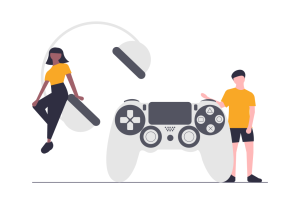
DS Formació's gamified language course
- Gamification
- PrimaryEducation
- LanguagesLearning
Due to the impact of the COVID-19 pandemic, DS Formació recognised the need for instructors capable of implementing blended learning. This approach catered to individuals who generally preferred in-person classes but, due to circumstances such as illness, did not wish to miss weeks of classes and were willing to participate online. Every class held its importance, especially for those preparing for upcoming exams, trips, job interviews, and more.
Context
Amid the COVID-19 pandemic, DS Formació recognised the necessity for educators proficient in delivering blended learning. This approach was intended for individuals who generally preferred in-person classes but, due to illness or other reasons, did not want to forgo their classes. Consequently, DS Formació, located in Reus, collaborated with DomSpain between December 2022 and April 2023 to conduct a case study and apply the methods and techniques demonstrated in the BLITT Bridging Course. The case study primarily focused on English classes, a subject area in which DS Formació had specialised since 2008.
People Involved
DS Formació, located in Reus, specialises in review courses and language courses (English, German, French, Italian, and Russian). The lecturers at DS Formació possess qualifications in psychology, primary education, e-learning, early childhood learning difficulties, or philology.
Karolina Bandura, a lecturer with a Bachelor’s degree in English Philology and a Master’s degree in English Studies, led this initiative. While already familiar with various online and blended learning tools before the BLITT Bridging Course at TU Dublin, the course further expanded her knowledge and enhanced her qualifications.
The course group consisted of three students, aged between 10 and 11 years, with the objective of improving their language skills and revising material covered in their regular school classes.
Before the transformation
Previously, some students encountered challenges in consistently attending classes due to illness or transportation difficulties. When the COVID-19 pandemic necessitated
a shift to a virtual learning environment, DS Formació sought to diversify
their offerings to accommodate individuals who found blended or online courses
more convenient. Karolina’s English course was originally designed for
in-person instruction, emphasising participation and team cohesion. Adapting it
to a blended format presented a significant challenge while aiming to retain
the core values of enjoyable and effective learning.
The transformation
Prior to the pandemic, DS Formació had not provided any online courses, as all instruction had traditionally been conducted in a face-to-face format. However, they had to adapt to the new reality imposed by the pandemic.
Blended learning allowed students to choose between attending a class in person or participating online via Zoom. The sessions were organised to ensure that students present on the premises and those online could fully engage. Classes were not recorded, but provisions were made for recording in cases where one or more students were unable to attend.
Before the BLITT Bridging Course, Karolina primarily used a simple PowerPoint
presentation and relied on physical textbooks displayed via Zoom. During the
course, she became acquainted with new tools like Canva and Genially, which she
subsequently incorporated into her classes. These tools enhanced engagement,
improved the presentation of topics, and introduced elements of gamification,
including activities facilitated by Kahoot. The course structure remained
consistent; only the materials used were modified. Although the initial
adaptation of materials required substantial effort, it ultimately resulted in
significant improvements in her digital skills.
After the transformation
Technologies Employed
Tools for blended learning included a laptop with a camera, microphone, and an internet connection to facilitate Zoom connectivity.
Reflections
Challenges Faced

Issues related to internet stability and online distractions were encountered. Internet connection problems led to disruptions during class sessions. Younger students (aged 10-11) seemed to get distracted more easily when learning online. Addressing this issue requires a more dynamic and personalised approach to theoretical explanations, such as including students’ names in exercises, to reduce distractions.
The practical application of tools and techniques from the Bridging Course yielded positive outcomes. Students displayed heightened enthusiasm when learning through gamification, and the instructional videos created with Powtoon piqued their interest. Students no longer missed classes due to the convenience of online access. Overall, the experience increased student attendance and participation.
What went well?


Was it worth it?
Despite internet-related challenges, the transition to blended learning was generally considered a success. Karolina aims to be better prepared regarding internet stability for future implementations. She also intends to continually explore and adopt new online tools to keep classes fresh and engaging, thus avoiding repetitiveness.

Costs
DS Formació did not incur additional costs for this transition, as they already possessed the necessary equipment, and Karolina utilised free tools for her classes. While initially 9-consuming to adapt to the new tools, it is expected that this investment will yield efficiency in the future.

Effectiveness
Blended learning allowed students to attend class even in cases of illness, family trips, or other commitments, preventing them from falling behind. The tools introduced also enabled creative revision of information, improving engagement and digital skills..
